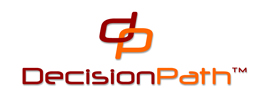DecisionPath's CALM solution helps organizations plan, validate, and execute strategies for organizational changes such as mergers, redesigning business processes, or introducing new enterprise software systems.
Problem: Conventional Change Management Is Costly and Ineffective
Most organizations understand that such transformations upset the status quo,
causing employee uncertainty, fear, resistance, reduced focus and performance.
They spend $50 billion annually on Change Management (CM) consulting to try to
forestall these disruptions by improving communications, modifying compensation
or workforce structures, and so on. Unfortunately, over 70% report that their
change management efforts fail. Government organizations report comparably high costs and failure rates.
These dismal results trace back to low levels of employee trust and other chronic problems with work environments. Conventional CM methods focus tactically on a specific change that is imminent, ignoring the fact that organizations face change on a continual basis. Conventional CM also applies the same kinds of mechanistic techniques used to manage projects such as new product development or systems integration. However, helping employees cope with major work changes involves more than simply allocating resources and careful scheduling; qualitative factors such as psychological, social, and cultural dynamics must be addressed explicitly to ensure success.
Problem: Enabling Change Is More Than a Numbers Exercise
Conventional decision support tools lack the horsepower required to address these
needs effectively. Spreadsheets and other simulators excel at manipulating numerical data,
projecting quantitative trends, and the like. However, they fall short in modeling and reasoning
about qualitative factors and interactions; uncertain and rapidly changing information; and disruptive events.
Capturing and leveraging expert knowledge about employee and organizational responses to disruptive change
is problematic. Planning exercises are valuable learning tools, but they are costly to conduct, so they
are staged infrequently. They also provide little insight into complex personal and social dynamics because
of our cognitive limitations in anticipating the likely evolution of situations involving numerous "moving parts".
Our Solution Approach: Practice Change Strategies and Measure Readiness Results
In contrast, we view readiness to change as a persistent strategic issue that
requires a deep "organic" understanding of organizational dynamics and cognitive psychology to address effectively. CALM stands for Change, Adaptation, and Learning Model. CALM defines a methodology and supporting software system that enable you to:
- Estimate your organization's initial readiness to respond to change
- Identify a target readiness state likely to ensure a successful transformation
- Simulate progress from the initial state towards that goal state under different scenarios about future conditions and alternate change strategies
CALM enables you to practice and compare alternate change strategies. These dry runs enable you to identify gaps in your plan and learn from errors at minimal cost: Mistakes in CALM exercises are virtual: you cause no actual blood, sweat, tears, or failures. Once you uncover these problems, you can refine your change strategies to improve their likely effectiveness.
Track Execution Results and Adapt if Necessary
Once you develop a robust change strategy, you must still execute it
successfully. CALM was designed to operate not only at the point of decision but
throughout the execution "lifecycle", enabling a sense and respond approach. This is critical because while you execute your transformation and change strategy, your environment invariably continues to evolve, and your stakeholders respond and adapt to those changes and to your strategy. In execution monitoring mode, CALM acts as an Early Warning System, helping you to detect problems promptly, diagnose them, and make effective mid-course corrections to ensure success.
Model Quickly and Easily with Pre-Made Building Blocks
CALM provides a library of pre-defined components for building scenarios
quickly. You populate these templates to describe your organization and its
readiness levels, pending transformations, environmental forces and anticipated
events, and your proposed change initiatives. CALM helps you assess
"infrastructure" readiness factors, such as business performance, processes, and technical capabilities. It also provides metrics for estimating readiness to change at organizational and individual levels, such as cultural alignment and teaming, employee self-confidence, emotional intelligence, and adaptability. The CALM library includes change initiatives such as improving communications, modifying compensation programs, and recruiting and training "change agents". Forces include internal and external factors such as economic conditions, new regulations, and leadership.
Uniquely Realistic Models Backed by Change Experts
CALM exploits "new science" theories such as system dynamics and adaptive agents to model how social and psychological readiness metrics change over time. These dynamics are pre-defined within CALM force and change initiative library elements, but can be easily adapted to fit your specific situation.
